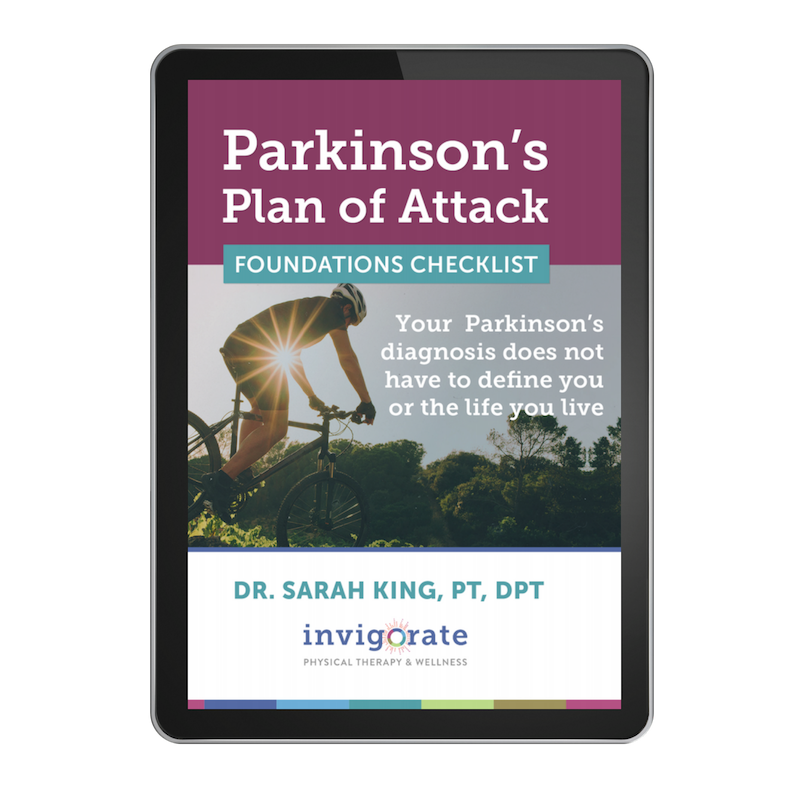As a physical therapist, I’m often one of the few healthcare practitioners that my clients spend more than 7 minutes with during an appointment.
(I’ll save my “Everything-that’s-wrong-with-our-healthcare-system Rant” for another day.)
This means I field a lot of questions my clients didn’t have a chance to ask their neurologist at their last appointment, including quite a few about Parkinson’s and Dystonia.
Below are a list of questions I often hear from my clients and our online community and my very best answers based on the most up-to-date research available. I’ve cited experts and research when I’m able to so you can find more information as you need it.
Please note: This article should not be taken as medical advice, only helpful resources for you to use and share with your own healthcare team. I highly, highly recommend discussing these topics with your Movement Disorder Specialist (MDS) or Parkinson’s neurologist before making any changes to your treatment regimen.
You can find an MDS in your area using this tool from Parkinson.org.
What is Dystonia?
Image courtesey: Michael J Fox Foundation
According to the Dystonia Foundation:
Dystonia is characterized by persistent or intermittent muscle contractions causing abnormal, often repetitive, movements, postures, or both.
The movements are usually patterned and twisting, and may resemble a tremor.
Dystonia is often initiated or worsened by voluntary movements, and symptoms may “overflow” into surrounding muscles.
Here's a great illustration of “overflow”:
It’s very similar to trying to open a very tight and stuck pickle jar. At first you start with just your finger muscles trying to twist the jar top off. When you need more force, you start to “overflow” into using your wrist, forearm, shoulder, and even torso to try and open that flippin’ jar! In the same way, dystonia can start in one muscle and “overflow” into surrounding muscles as it intensifies.
How is Dystonia different from Parkinson's?
You can have dystonia without having Parkinson’s (called "Primary Dystonia").
You can have Parkinson’s without having dystonia. Up to 40% of people with a Parkinson's diagnosis experience dystonia as a symptom or complication from treatment.
It can be difficult to differentiate, but the research suggests our genetics have a huge impact on which symptoms (including dystonia) are expressed with a Parkinson's diagnosis.
Identifying the origin of the dystonia plays an important part in determining the correct treatment plan, which is why it’s so important to work with a Movement Disorder Specialist.
Who Diagnoses and Treats Dystonia?
Movement Disorder Specialists.
These specialists are neurologists who went on to specialize in movement disorders. Because they are able to focus on a small subset of neurological conditions, they’re typically more up-to-date on the research, better able to tease out the subtleties in your symptoms, and therefore offer up the most effective treatment option (compared to a general neurologist).
Dr. Petr Kanovsky uses this 3 Step Process with his patients:
Identify the dystonia.
Get an electrophysiological examination to confirm the diagnosis.
Classify it and figure out its cause.
This process helps the MDS decide on the best course of action going forward.
Takeaway: If you aren’t seeing an MDS, it’s time to find one!
Where does Dystonia come from? What causes Dystonia in Parkinson's?
Dystonia has a large genetic burden in its etiology. Multiple molecular genetic mechanisms likely lead to dystonia and there is a lot of research coming down the pipeline identifying exactly which genes are most likely to contribute to symptoms.
Individual genes can contribute to deficits in dopamine metabolism, transcriptional dysregulation, or cellular stress pathways and lead to dystonia.
This brings me to a concept that’s important to understand: Epigenetics.
Epigenetics is the study of how your environment (like your diet, activity level, stress levels, and toxin exposure, to name a few) impacts the way your genes express themselves.
When you have a genetic predisposition for Parkinson’s or dystonia it means that you’re more at risk for developing symptoms. In epigenetics, your environment determines if you actually express those symptoms or not.
In a nutshell: Genes load the gun, and environment pulls the trigger.
This is why it’s so important to live in a healthy environment that takes care of your genes. Eating properly, exercising regularly, managing your stress, and avoiding toxins all help you feed your genes for success instead of degeneration.
If you need help with getting into a regular exercise program, I’d highly recommend you check out Invigorate’s online program: www.InvigoratePT.com/Booster
Finally, there are some medications can contribute to dystonia. For a more extensive explanation and list, please visit this informative post from the Dystonia Foundation:
Learn More about Drug-Induced Dystonia from the Dystonia Medical Research Foundation (DMRF)
Where Does Dystonia Present with Parkinson’s?
Dystonia can present in a variety of ways and locations and you should work with your MDS to tease out exactly which category your symptoms fall under.
Dystonia can present in a variety of locations:
Focal Dystonia
"Focal" means it appears in one place, like cervical torticolis (in the neck) or blepharospasm (eye spasms).
Multi-focal Dystonia
"Multi-focal" means it appears in two places, like the tongue + neck for example.
Generalized Dystonia
This means dystonia is occurring throughout the whole body.
Hemidystonia
"Hemi" means "half", so you'd experience dystonia in half the body: Your right arm and Your right leg, for example.
Dystonia can also be task-specific, meaning it mostly presents when you’re doing a specific activity like writing (“writer’s cramp”) or playing an instrument (“musician’s dystonia”).
Which Medications Cause Dystonia?
Some medications can cause what’s called “drug-induced dystonia”.
This can be acute (meaning immediate onset) or tardive (meaning delayed onset).
Acute Dystonia
DEFINITION: Dystonia that appears after taking a new medication and typically happens within a few days of the new prescription.
In this case, this is what your MDS / neurologist may do:
Discontinue the causative drug
Use an Anti-cholinergic instead
Typically acute dystonia decreases in a week of discontinuing the drug that caused the issue, however it could take longer in some cases.
Tardive Dystonia
DEFINITION: Dystonia that appears after taking a new medication but is delayed in its appearance, not necessarily appearing immediately after starting the new drug.
As you can imagine, this type of dystonia is harder to identify due to the delay in onset.
If you experience tardive dystonia, your MDS / neurologist may discontinue the causative drug, if possible. However, if the drug is mandatory they may suggest you continue to take it.
Note: When you discontinue the troublesome drug, your symptoms may worsen. In this case, your physician may ask you to re-introduce the causative drug in a small amount and monitor your reaction.
Tardive dystonia symptoms may persist for a long time.
The list of medications that can cause acute or tardive dystonia is long. Head over to The Dystonia Foundation's website to read an in-depth discussion of specific medications: Drug Induced Dystonia.
How to Treat Parkinson’s Dystonia
Oral Medication
In Parkinson’s dystonia, your MDS / neurologist may suggest a trial of l-dopa to see if you have"dopa-responsive dystonia.
Medications like trihexyphenidyl, diazepam, or clonazepam are typically prescribed for dystonia.
Botox
Typically botox is the 1st choice for focal dystonias like:
Blepharospasm (eye spasms)
Cervical dystonia (neck)
Upper and lower limb dystonia
Laryngeal dystonia (voice box)
Surgical Interventions
Deep Brain Stimulation is typically the 1st choice for generalized dystonia.
Note: Transcranial Magnetic Stimulation (TMS) is still in the experimental phase to determine its efficacy for dystonia, but may be an option in the future.
Rehabilitation
Physical therapy serves as a supplement to other methods and can increase the efficacy of approaches like oral medications, botox, and deep brain stimulation.
Imagine these approaches are like training wheels which unlock your ability to move more efficiently.
Therefore working with a neurological physical therapist will help you improve your strength, coordination, and flexibility while your dystonia is less intense.
While we haven't discussed these conditions in depth, physical therapy is the 1st choice in Camptocormia and Pisa Syndrome.
Acupuncture
Acupuncture can be helpful to suppress the overflow and co-contractions that happen with dystonia. This is also a treatment that is often used in conjunction with other treatment techniques.
Dance?
In the healthcare communities, we rely heavily on research and traditional treatment methods.
However, we must not forget that there are plenty of options out there that have worked for many people, even if they aren't the most thoroughly researched techniques.
This talk from Federico Bitti at TedXNapoli illustrates how dance was the key that unlocked the door for his dystonia symptoms.
The takeaway message: Keep searching for answers and follow your intuition about what is working for you.
What makes Dystonia worse?
Stress!
This can come in the form of:
physical stress,
emotional stress,
lack of sleep,
fatigue,
an illness (UTIs or pnemonia, for example),
an injury,
dehydration,
traveling or changing time zones, and so forth.
Your best approach is to minimize stress in any way you can.
Here are some basic strategies you can use:
Stick to a regular sleep/wake routine.
Exercise regularly and on a schedule.
Eat healthy foods and stay hydrated.
Spread your energy out over the course of a day as well as throughout the week. (Try to avoid “Superhero Days” when you do everything just because you’re feeling good!)
Take up a daily mindfulness or breathing practice to reduce anxiety.
Get outside in the sun early in the day (before 10am).
Say “No” to things you know are going to stress you out.
Try acupuncture to reduce anxiety, stress, and improve sleep quality.
Note: A sudden and significant change in your dystonia symptoms can be an indication that you may have an illness, infection, or something else that may be acutely exacerbating your symptoms. If this is the case, get in touch with your neurologist immediately to be screened.
How does Dystonia affect Walking?
Dystonia can worsen with exercise, especially in the calves and feet.
Discussing these symptoms with your neurologist is crucial so they can help you optimize your medication dosages in order to allow you to workout effectively.
Working with a physical therapist to improve your strength and flexibility in your lower body can help you improve your endurance and walking tolerance and is commonly combined with other approaches like oral medications, botox, or Deep Brain Stimulation.
Are there Supplements for Dystonia?
No supplements are heavily supported by the research to treat dystonia directly.
Do you have a Parkinson's Plan of Attack?
Most people don't! Snag your free copy of Sarah's Parkinson's Plan of Attack Foundations Checklist PDF to start re-defining your diagnosis.











